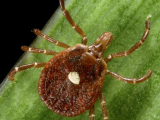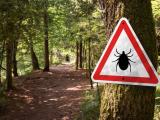A statement yesterday from the Entomological Society of America (ESA) called for a national strategy to invest in approaches that address the spread of ticks and the rising prevalence of tickborne diseases in humans.
Tickborne diseases are responsible for about 300,000 human illnesses per year in the United States, accounting for $700 million to $1.3 billion in annual costs, the ESA said. The economic burden on public health systems is estimated to be at least three times higher.
Strategy and priorities
Research, training, and development of technology are at the heart of the ESA's strategy, partly because ecological changes and the identification of new tickborne diseases have led to what ESA President Phil Mulder, PhD, calls a "tick literacy deficit" in both scientists and members of the public.
"The rapid rise in tick-borne diseases is a critical national issue. A recent confluence of environmental, ecological, sociological, and human demographic factors has created a near 'perfect storm, ' leading to more ticks in more places, " Mulder said.
The statement advocates for an integrated approach among universities, industry, and government to addressing tickborne disease, noting that entomologists have unique capabilities to help prevent human disease.
New diseases, expanding Lyme threat
Its priorities come on the heels of new tickborne diseases identified in the United States over the past several years and the increasing spread of ticks across the country. Bourbon virus, which was identified in 2014 after it caused the death of a Kansas man, currently has no treatment or vaccine. Heartland virus was first identified in 2009 after it severely sickened two Missouri men.
The ESA requests policies and investments that strengthen research into development of vaccines, repellents, attractants, and acaricides. Also of high importance are ecological surveillance technologies and methods that will allow researchers to visualize interactions between ticks, their animal hosts, and the landscape.
Lyme disease, which is spread by deer ticks and can cause severe illness, continues to gain a foothold across the United States. A 2014 North Dakota survey found that ticks carrying the pathogens that cause Lyme disease and anaplasmosis had spread into the state. A study in upstate New York found that a sample of deer ticks carried multiple pathogens, potentially exposing people to more than one disease with a single bite.
Investing in new partnerships
The ESA statement emphasizes that gains in preventing tickborne disease will come with greater investment in training professional entomologists and citizen-scientists to monitor tick biology and pathogens. International partnerships that prevent introduction of new diseases are also a key focus of the statement; the ESA estimates that preventing new tickborne diseases from entering the US would save the livestock industry more than $3 billion each year.
An integrated approach focused on scientific research, ecological understanding, training for new scientists, and partnerships with those who can translate research into technology will "solve the tick problem," asserts the ESA.
See also:
Aug 10 ESA statement
May 29 CIDRAP News scan on second Bourbon virus case
Feb 20 CIDRAP News scan on first Bourbon virus case
Sept 12, 2014, CIDRAP News scan on Lyme disease spread
Jun 20, 2014, CIDRAP News scan on Lyme disease coinfection
Jul 22, 2013, CIDRAP News story on Heartland virus





















